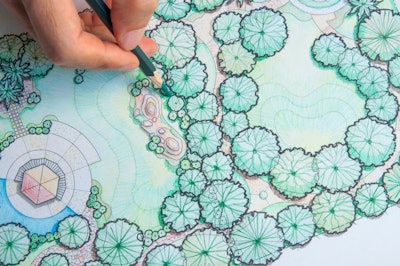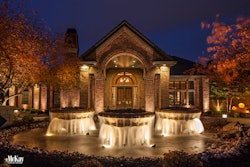
Beautiful garden and lawn creations don’t just happen without a green industry professional with an eye for design and the ability to make those plans happen, so take a look at a few concepts to keep in mind when working to create a landscape design that is not only functional but also embodies an artistic atmosphere.
Massing and proportions
Regardless of how small or large your customer’s space is, massing can always serve an artistic purpose.
When referencing massing in a landscape, it simply means that you will take one type of plant and group it into one big section. Massing has been used for ages to achieve well put together looks in lawns.
When you plant a large group of one plant tightly together, you are able to achieve a good visual impact, and it also works to balance and proportion out the landscape. If plants aren’t massed together, it can sometimes be difficult to achieve this same aesthetic impact with plants scattered in little groups here and there.
When plants are massed together, it helps create texture, form, larger pops of color and it can reduce maintenance in some situations. Plus, when comparing the landscape to surrounding features like houses, large trees and other buildings, massing the plants together can help them stand out from their competition.
But how many plants do you need in an area to consider it massed? A general rule of thumb is at least five plants, but this will vary based on the size of the space and mature size of the plants. When working with grasses, woody shrubs, sturdier perennials, groundcovers and sometimes annuals, this technique will work well.
There are also the options of incorporating both vertical and horizontal layers to create more unique massing looks.
Vertical layers take place at the ground level and include turf and plants that grow about 6 inches high. These plants cover the soil and can serve as the composition baseline. In the foreground layers, plants will usually be about 6 inches to 2 feet tall.
When massed together, these smaller plants can work to form the edge of plant beds to serve as the transition to larger plants. The midground layer is the next and consists of plants from 2 to 5 feet tall. These plants will take up most of the space and can serve several functions, such as creating special definition, creating color and texture and more.
The last and tallest layer features the background plants and consists of trees and larger shrubs. These are often used to block views or provide shade.
Horizontal layers are considered the plant masses that interlock and overlap from the plant bed’s front and run to the back of the bed along the ground.
Any plant masses here should vary in depth across the front of the bed, just like the height should vary along the top of the plants. Overall, it’s good to stick to two simple rules when it comes to creating horizontal layers: space the individual plants enough so they don’t touch each other once they’ve completely grown and overlap the masses to connect them and make them flow with no space between them.
Be sure to keep large gaps and open areas from appearing between the masses, as any voids will attract more attention and distract from the overall look you’re wanting to create.
One of the most vital aspects of a successful garden design is proper proportioning, especially if the space has a pool, patio, outdoor kitchen or other similar structure, as their size must fit accordingly with the size of the house.
When it doubt about how a structure such as those previously listed will fit in a landscape, experts say to err on the side of caution and make the structure merely a design feature and not a dominant element.
Working with smaller spaces
If your customer’s space is smaller, try to accentuate long views across the garden, as this will help add a greater sense of depth to the area. Instead of creating paths that haphazardly wind around, consider keeping the pathways in one continuous, straight line, as this will help emphasize the garden’s length and create more dramatic focal points at each end.
When it comes to adding in plant life to your customer’s garden, experts agree that sticking with native species is the way to go, as these plants will often be the most resistant to pests and more durable once established.
Native plants are those that are indigenous to a certain area, ecosystem or habitat and were present prior to European settlement. They are also best adapted to the climate and soil they grew up in, which means they tend to need fewer resources and care than other non-native plants.
If clients desire a tropical look, consider adding in native plants to the background of the landscape and strategically layer in showier plants that have a tropical look to them to create the atmosphere they desire while still holding on to the native species.
Landscape lighting also plays a major part in any garden or lawn design, as customers are almost guaranteed to want to enjoy their space both during the day and evening.
When adding in lighting to your customer’s garden or lawn, keep in mind that you want to eliminate hot spots, as these will make the lighting look unnatural.
Remember that you’ll also want to utilize lighting to highlight features in the landscape that should be accentuated, which will also let less important aspects fade into the background.
If your clients have a tiny garden area that’s limited on ground space, don’t forget that you can always go up. Smaller gardens will feel larger if you are able to draw the eyes up and over the neighboring fence. Take advantage of vertical gardens along the fence line, running up an arbor or trellis or stretching upward on a brick wall/side of the house, or ask your customers how they feel about having some tall trees planted near the fence line.










